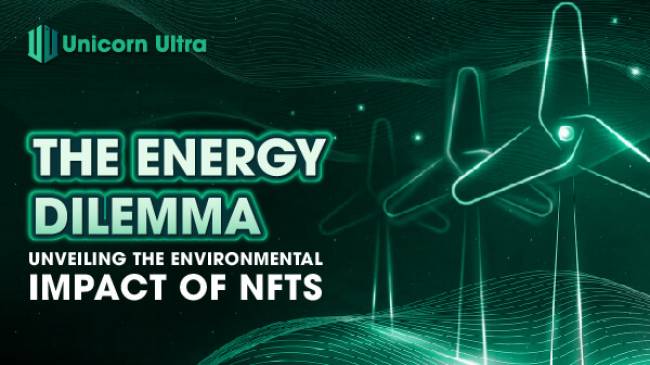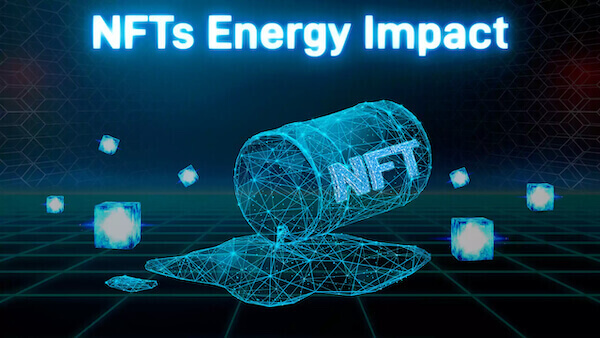In recent years, the world has witnessed an unprecedented surge in the popularity of NFTs (Non-Fungible Tokens), revolutionizing the way we perceive ownership of digital art and collectibles.
Table of Contents
Do NFTs use a lot of energy?
The initial surge in mainstream crypto-collectibles occurred in 2017. Nowadays, due to NFTs operating on a blockchain infrastructure, the energy consumption has become significant. Ethereum, for instance, consumes approximately 31 terawatt-hours of electricity annually, which is roughly equivalent to the annual energy usage of Nigeria.

How much energy do NFTs use?
Estimates suggest that creating an NFT on the Ethereum platform consumes over 260 kilowatt-hours of electricity. This is equivalent to the electricity consumed by an average American household in a span of 9 days.
To calculate the energy consumption of an individual NFT transaction, one must take into account all the elements of the process. For instance, each transaction consumes as much energy as the average household does in a day and a half.
This calculation excludes the following factors:
- Minting: 142 kWh, 83 KgCO2
- Bids: 41 kWh, 24 KgCO2
- Cancel Bid: 12 kWh, 7kgCO2
- Sale: 87 kWh, 51 KgCO2
- Transfer of ownership: 52 kWh, 30 KgCO2
These statistics reveal that the typical NFT utilizes approximately 340 kWh of energy and results in emissions of around 211 KgCO2.
When you multiply this by a minimum of 8,000 transactions, the outcome is an enormous NFT carbon footprint.
NFT Energy Consumption Comparison
The estimated energy consumption of an NFT, approximately 340 kilowatt-hours, does not account for additional processes such as design work or extra blockchain transactions. Therefore, pinpointing the exact NFT energy consumption remains challenging.
However, it is estimated that the energy expended from creating an NFT to completing a sale could power a three-hour flight.
The primary contributor to the kilowatt consumption in the NFT process is the proof-of-work algorithm, as numerous miners simultaneously compete to validate the NFT tokenization. This simultaneous solving of complex random algorithms significantly escalates NFT energy consumption. Since only one miner can successfully complete the process, the efforts and energy expended by the other miners become redundant.
The table below illustrates a comparison of NFT energy consumption with traditional energy consumption:
|
NFT Energy Consumption: 263,538 kWh NFT Emissions: 163,486 KgCO2 | |
| This is equivalent to: | The energy consumption of an EU resident over 77 years. |
| The combined duration of 1.5 thousand hours of flights. | |
| The amount of petrol used to cover 838,000 kilometers. | |
| Boiling a kettle 3.5 million times. | |
| Using a laptop continuously for 2,500 years. | |
| Operating a computer non-stop for 636 years. | |
In under half a year, a sole artist's multiple-edition NFTs have generated an NFT carbon footprint equivalent to 260 MWh of energy and 160 tons of CO2 emissions.
What type of energy do NFTs utilize?

Beyond the quantity of energy consumed, it's essential to consider the sources of energy powering NFTs. The majority of PoW-based blockchains, like Ethereum, rely on fossil fuels for energy. This dependence raises concerns about the industry's contribution to global warming and the depletion of finite resources. Transitioning to renewable energy sources is a potential solution, but it requires a concerted effort from both NFT platforms and the blockchain community.
Reducing NFTs' Energy Consumption
As the environmental concerns surrounding NFTs grow, various strategies are being explored to minimize their energy footprint:
Proof of Stake (PoS): Unlike PoW, PoS is a consensus mechanism that doesn't require miners to solve resource-intensive puzzles. Instead, validators are chosen based on the number of tokens they hold and are willing to "stake" as collateral. This switch from PoW to PoS can significantly reduce the energy consumption of NFT platforms.

Layer 2 Scaling Solutions: Layer 2 solutions, like Optimistic Rollups and zk-Rollups, aim to alleviate the strain on the main blockchain by processing transactions off-chain and then bundling them together before committing to the main chain. This approach improves efficiency and reduces energy consumption.
Eco-Friendly NFT Platforms: Some emerging NFT platforms are designed with energy efficiency in mind. These platforms utilize PoS or other energy-efficient consensus mechanisms, thereby reducing their carbon footprint.
Carbon Offsetting: NFT platforms and artists can collaborate with carbon offset projects to neutralize the environmental impact of NFT transactions. By investing in initiatives that reduce greenhouse gas emissions, the NFT community can mitigate their ecological footprint.
Conclusion:
So, how much energy do NFTs use? The energy consumption of NFTs is a significant and pressing issue within the community. It has reached a substantial level, with impressive figures. Transitioning to energy-efficient solutions and utilizing renewable energy sources may be a way to reduce the environmental impact of NFTs. This requires contributions from all stakeholders, including artists, NFT platforms, and the collector community, to ensure that the growth of NFTs does not come at a significant environmental cost.






